‘Behemoth’ is a word which springs to mind or, perhaps more nautically, ‘leviathan’.
- Elegant styling
- Massive cockpit
- Responsive handling
- High-quality interior
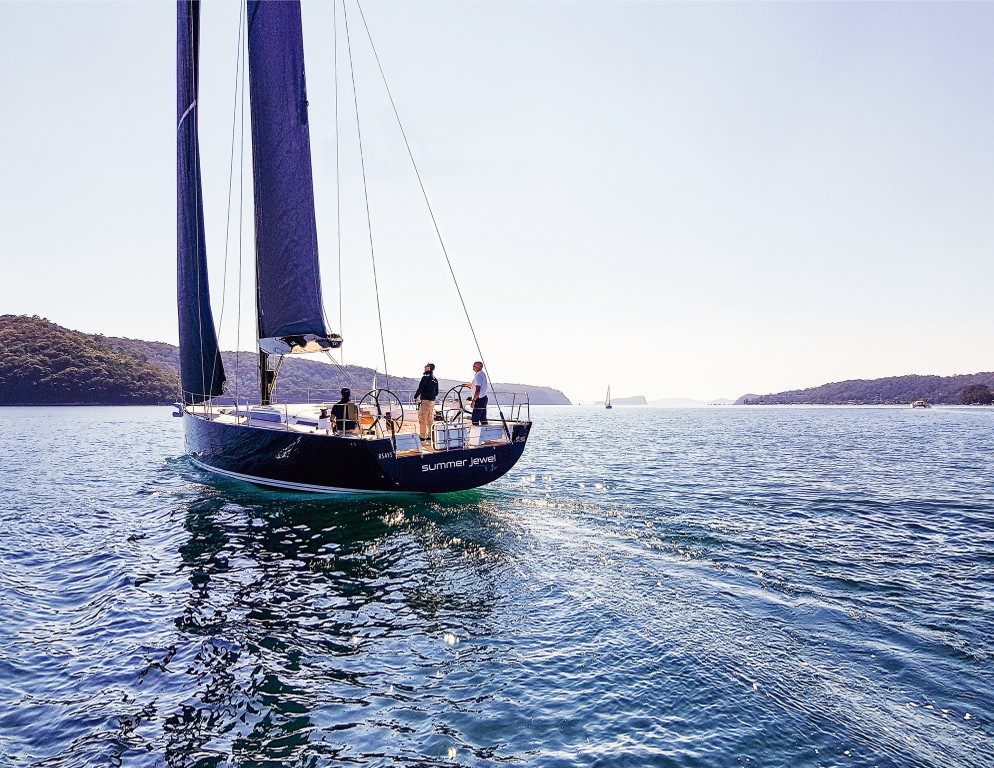
‘Built for sailors’ is the mission statement on the plaque at Italy’s Solaris yard and after a day spent on this slippery 50-footer Kevin Green would agree.
There was excitement in the air when Aussie/NZ dealer Windcraft Yachts sold its first Solaris 50 this year – understandable given its experiences with the smaller 42 and latterly the 47. Having sailed them and been on the newest (the 44) in France, I had high expectations for the 50. And they were exceeded when I took her to sea off Sydney.
A well-proven model, the Solaris 50 has sold strongly since its 2014 inception and our review hull was number 39 – a high number for a hand-crafted performance cruiser like this. The Adriatic-based yard produces about 40-50 of these premium yachts annually from a range that currently comprises nine production models between 37 and 72 feet.
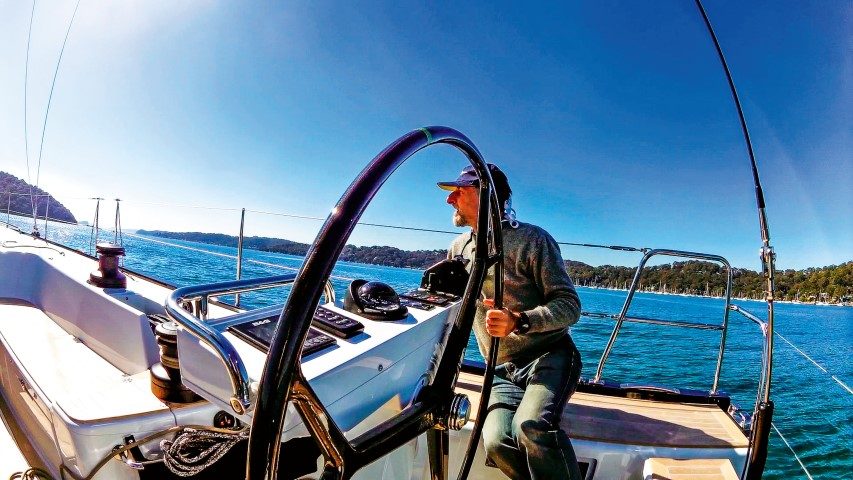
The 50 continues the range’s familiar snub bow, low-profile coach roof and wide beam tucked in by chines; striking lines drafted by Argentinian naval architect Javier Soto Acebal. The shape echoes a Swan, which is unsurprising given Acebal’s worked for Nautor Swan designer German Frers for a decade.
Like Swan, quality is at the heart of the privately-owned Solaris yard’s philosophy and one reason why it has produced the iconic Wally supermaxis in the past, clearly demonstrating the standards of this relatively small builder operating near Venice.
So the 50 comes with plenty of pedigree, a fact that attracted a new owner in South Australia, a lively cruising ground where the mighty Southern Ocean crashes into the continent. For those of you who’ve yet to compete in the Adelaide to Port Lincoln Blue Water Classic, I’d urge adding it to your Bucket List. The last one I did, at the helm of a Beneteau First 51.1, was a thrilling ride skirting majestic rocky coasts and secluded bights – ideal for cruising.
Done in a near gale, there was unfortunately little time for sight-seeing. The reward for 20 hours of hardship was the regatta racing in the smooth waters of Boston Bay, something this slippery Solaris 50 would excel at given its Mediterranean styling.
Versatile & powerful sail plan
For hull #39’s good performance, credit must go to the local North Sails loft for the powerful suit of sails bent on to this first Australian boat. The result is an optioned-up version with full carbon rig from Hall Spars held up by rod rigging, twin hydraulic backstays and a deep, lead-bulbed keel to give a fairly good stability ratio (34%), enhanced by form stability from the ample 4.55m beam.
The versatile sail plan included an easily-operated self-tacking headsail, along with genoa and G2. An asymmetric spinnaker is also in the armoury and for dead downwind, a symmetrical with pole is pending. “The Park Avenue boom has the advantage of supporting a large racing mainsail and holding it neatly when you drop it,” explained my host for the day, Windcraft’s Ric Hawkins.
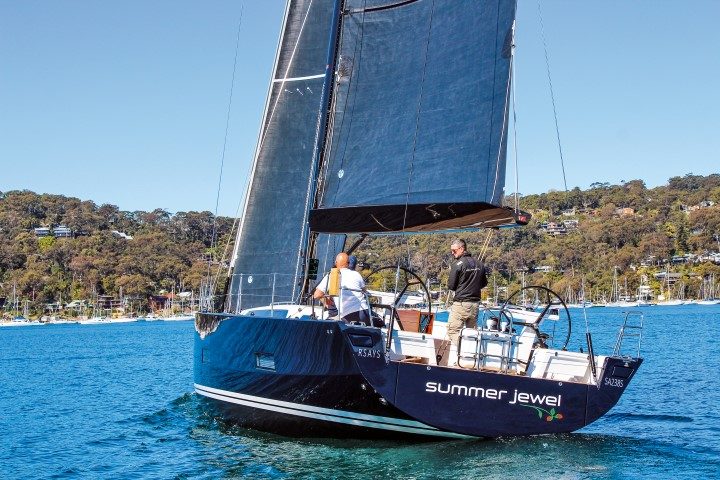
A fully-clad natural teak deck gives a stylish finish to the semi-flush topsides of our review boat but Solaris also offers a synthetic version (which in theory is longer lasting and claims fairly good heat dispersal). Natural wood also gives a good grip for crew moving around the large, open cockpit on the 50. This layout suits both crewed racing and more relaxed cruising modes. Offshore, the semi-flush deck style can be exposed so the retractable sprayhood is necessary.
Behind it are most of the sail controls including three sets of Harken Performa winches (electric primaries) located near the binnacles but with enough space for both short-handed and crewed operation. Another set of electric Performas control the German mainsheet which is secured on a single block towards the end of the boom, so offering good control and ability to put twist in the 3DI sail. On the coaming, enclosed gutters neatly guide all lines into jammers and the winches behind them with tails stored in rope bags below.
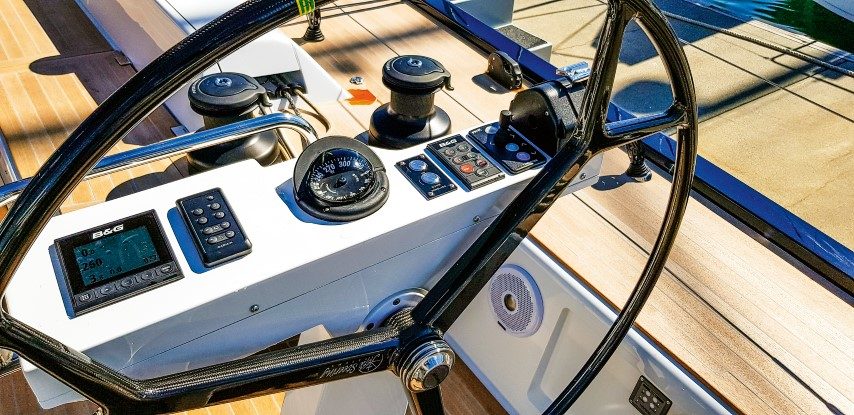
Each binnacle houses B&G screens (with jumbos on the mast), a compass and the obligatory autopilot. Power controls for the upgraded Volvo 75hp are conveniently placed on the starboard binnacle with other controls at ankle height.
Another wise option is the drop-down Maxpower bow thruster, allowing easier berthing. Locker space is good in the cockpit with bench storage on both sides around the sturdy hardwood table which can also be a foot brace when heeled. But not to my liking is the fashionable saloon-style doors on the main hatch, instead of traditional washboards or elevating ones.
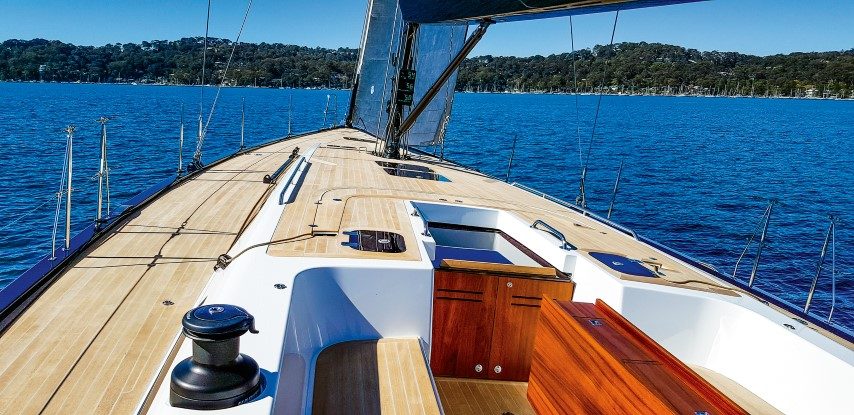
Underfoot is a hatch for quick access to the dinghy garage. The open transom leads to the hydraulic, teak-clad swim platform which drops to nearly sea level, allowing the inflatable dinghy to be easily launched. The liferaft was sensibly located inside the transom rail allowing quick deployment.
Throughout the cockpit the quality of this Solaris is obvious, including the sturdy composite binnacles, solidly bolted and glassed into the hull and the carbon Jefa steering wheels which also add to the yacht’s stylish finish.
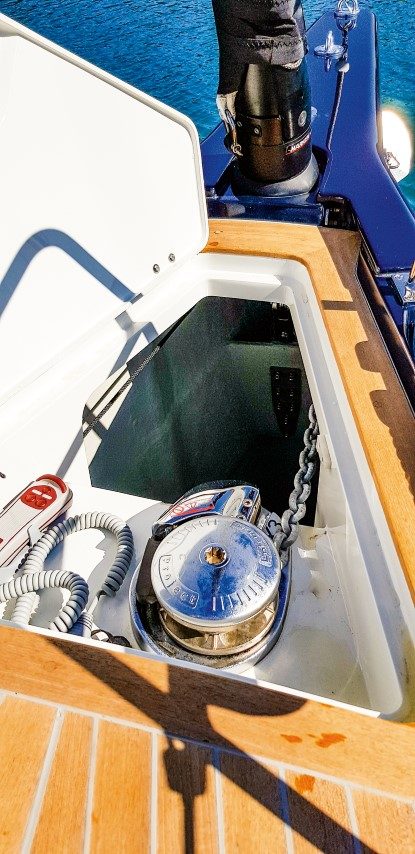 Walking along the wide decks, there is little to trip the crew going forward, thanks to flush hatches, outboard shrouds and grippy teak under-foot. Notable points include handrails on the coachroof, folding cleats all round, including midships and an integrated fibreglass toerail that helps on the foredeck when heeled, although it’s not so comfy for hiking.
Walking along the wide decks, there is little to trip the crew going forward, thanks to flush hatches, outboard shrouds and grippy teak under-foot. Notable points include handrails on the coachroof, folding cleats all round, including midships and an integrated fibreglass toerail that helps on the foredeck when heeled, although it’s not so comfy for hiking.
The bow is streamlined nicely, thanks to the systems – windlass and roller furler – hidden below hatches.
A comprehensive anchor setup includes a vertical 1500W Lofrans windlass, deep chain locker and the anchor is neatly integrated into the optional fibreglass bowsprit. The bowsprit is strong enough to fly a Code 0 headsail without requiring a bobstay and there’s plenty of separation from the forestay. Also here is a large sail locker for the running sails.
Carbon-reinforced hull
Volume and beam are generous, which creates a spacious hull with a discrete chine running aft from midships and fine plumb bow ideal for going to windward. Generous topsides allow for a semi-flush deck profile which is particularly suited to regatta sailing but in cruise mode the deep cockpit and elevating spray hood is welcome.
Another welcome cruising feature is the large dinghy garage for a tender to slide in sideways. The hull and deck are of vacuumed (PVC Airex Core) in e-glass polyester and the keel-stepped mast sits on an integrated fibreglass grid connected to the longitudinals. Lifting the floorboards, I found the keel bolts to be oversize and the keel uses a flange to spread its load through the hull.
Structurally, these are stiff boats, thanks to unidirectional and bi-directional carbon rovings across high load areas such as keel, engine bed and shrouds. Also, the main bulkheads are bonded to the hull and deck, which is constructed from composite foam sandwich.
Stiffness is further enhanced by the deep lead bulb, which supports the sizeable racing sail wardrobe. Steering gear is quality Jefa linkages attached to a balanced GRP, foam-cored spade rudder which proved extremely powerful at sea.
Customised interior
The three-cabin layout has the owner’s ensuite forward with two doubles aft and there’s a second bathroom here as well, which has a useful wet locker draining into the shower. An alternative layout with offset owner’s bed creates some lounge space in the forepeak as well.
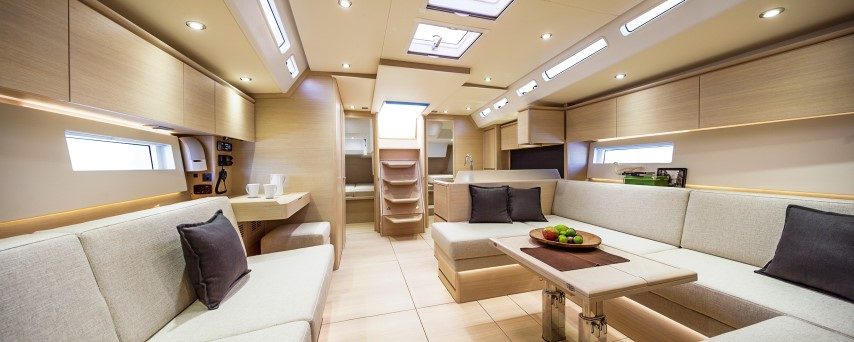
A choice of finishes and customised woodwork, such as the overhead lockers and navigation station joinery in our reviewboat, gives owners an extensive choice below decks. Other traits of a premium marque include matching grain in various woods including a light or dark oak-finish throughout the saloon, with the former variety adding a bright ambience on the review boat.
A superb finish and the close mating of joints really shone on this fit-out with quality metal cupboard and door fittings throughout. Smart touches included integrating handholds in the fiddles and a sensible longitudinal ceiling rail to guide the owner forward.
The layout has the U-shaped couch forward and the lounge is opposite to starboard. The dinette table is solid wood with two chairs midships (which are pinned to the cabin sole) while over on starboard the chart table is ideally placed near the companionway allowing the navigator to easily view the cockpit and outside via a rectangular portlight.
There’s bulkhead space here for electronics (the main electrical panel is in an overhead locker) plus a custom-made plotter screen-box. Opposite, the L-shaped galley is well-equipped with a three-burner stove/oven plus microwave above that can run off the inverter-generator. The generator can also run the optional air conditioning.

Perishables live in a deep chest fridge and a front-opening unit, while dual sinks finish off the area. The composite work surfaces and tall fiddles should allow easy food preparation and there’s an opening hatch above the stove. Hatch space throughout is good with rectangular hull portlights, coachroof windows and two opening skylights.
The owner’s ensuite forward uses the tall topsides and plumb bow to create an airy cabin with island bed (with storage beneath even with the thruster fitted) and it’s surrounded by overhead lockers and tall wardrobes. The ensuite came with an upgraded electric head and perspex door separating the shower with a quality teak grating underfoot.
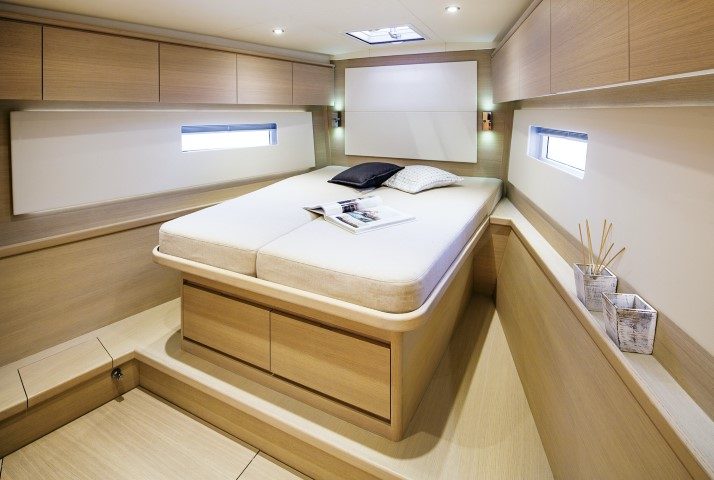
Looking aft, the two double cabins offer conventional berths but one can be divided into singles. Natural light is a wee bit limited, through the two small hatches. Unlocking and lifting the hinged companionway steps on their gas struts reveal the Volvo saildrive which has sufficient space around it for servicing, especially when the side access doors from each cabin are removed; the main batteries are nearby as well.
Charging them is via dual alternators. Our review boat had a feathering propeller fitted – ideal for reducing drag on a performance cruiser.
Zephyrs on Pittwater
Motoring out to a calm Pittwater, the Volvo pushed us along at 9 knots with no vibration in the hull. Awaiting us were mere patches of ruffled water, so I headed for the nearest in the hope of some sailing while Ric Hawkins and crewmates hoisted the mainsail using the two-speed electric winch, then unfurled the genoa.
As I turned the Solaris 50 off the breeze I leaned beyond the binnacle to winch the genoa sheet, and given the six knots of true wind, I was surprised we could kill the engine. Acceleration and response was, of course, greatly aided by the beautiful cut of the North 3DI sails which clearly relished the light airs.
Sitting out on the coaming with only a light hand on the large wheel, the position felt very comfortable as I watched the tell-tales go horizontal on the genoa. The Garmin mast jumbos showed our speed to be 5.6 knots in six knots of breeze, albeit on calm water, while the apparent wind angle was a sharp 23°.

This light air exercise clearly demonstrated the merits of a performance-cruiser, whereas sailors in more conventional ones would be reaching for the engine starter button. Tacking was briskly done without much loss of momentum and the sheets ran cleanly as the genoa rolled past the mast with the tracks perfectly placed to flatten out the carbon sailcloth.
Handily, I could trim the headsail from the helm, while the crew also had enough working room to do this. Turning off the dying five-knot breeze I expected the beamy hull to pay the price for its proportions but was pleasantly surprised as the numbers showed 3.1 knots at 140°, confirming that Solaris 50 is slippery and a true joy to sail.
‘Behemoth’ is a word which springs to mind or, perhaps more nautically, ‘leviathan’.
White Pointer has earned the respect of discerning customers in New Zealand and Australia, attracting a loyal and ever growing following for its high-quality, rugged and totally dependable aluminium trailer boats.
The hardtop SP635 shares the same underpinnings as the popular SF 635 which was a completely new model back in 2020.
The pride and joy of a multi-generational family, Bliss resides on a pier that’s home to a couple of other Elite motor launches – Sandspit Marina is a hot-spot for the Bill Upfold-designed vessels, with several calling this small marina home.